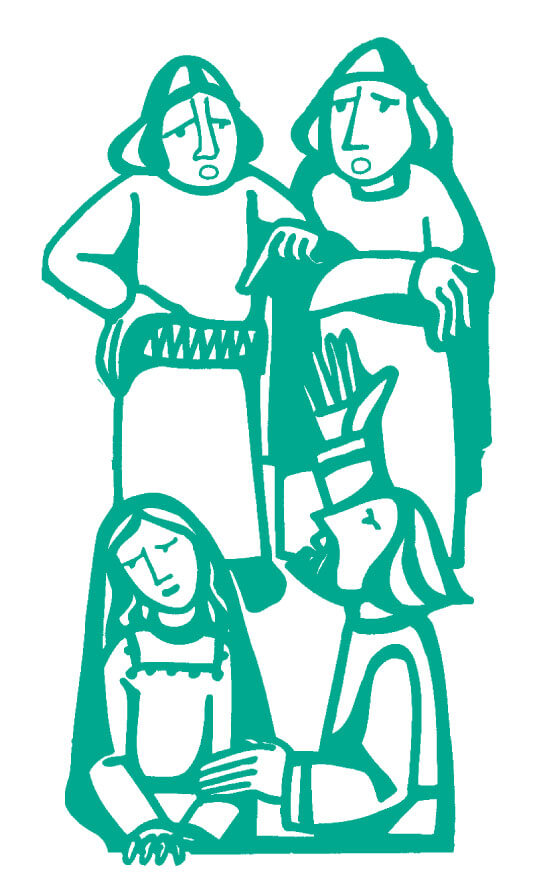
Only John’s gospel tells the story of the hypocrites who use a woman they catch in adultery to trap Jesus. The story fits uneasily in John’s narrative and reflects themes more common in Luke, which we read during Lent this year and which emphasizes second chances and forgiveness.
Scholars conclude that this story is a late addition to John’s gospel — perhaps the third century — and that an editor fit the story into the conflicts Jesus faces in Jerusalem. Crowds think Jesus may be the Messiah. Temple police sent to arrest Jesus don’t do it because his teaching so amazes them. This leads a group of scribes and Pharisees to set the trap that forms Sunday’s gospel. They set Jesus up to speak against the law of Moses.
The dynamic between Jesus and his opponents is exquisitely subtle. It is early in the morning and people are gathering in the temple area to listen to Jesus when the scribes and Pharisees appear, greeting him as Teacher, and announcing that they have a woman whom they have “caught in adultery.”
According to John’s gospel, the Romans have denied the Jews the right to administer the death penalty. Both Jesus and his opponents know this and know that the Mosaic law prescribes stoning a married women guilty of adultery (Deut. 22.23-24). Actually the law calls for stoning both a man and woman caught in adultery.
In this story Jesus confronts individuals that can exist in any religious group or organization — those who are inflexibly certain they are right. Jesus’ opponents publicly shame the woman in order to trap Jesus in a no-win situation. Jesus either rejects the law of Moses that requires stoning or breaks the Roman law against carrying out capital punishment.
- Where is the man with whom the woman was caught in adultery?

No real evidence exists that first-century Jews enforced the Mosaic law against men and women who commit adultery. The law prescribes that both be put to death (Leviticus 20.10; Deut. 22.22). A man caught in adultery has already walked away in secret before this gospel story begins.
Instead of standing up to his accusers and falling into their trap, Jesus bends over and writes in the dirt. His silence and attentive writing create space for them to see themselves. Instead they persist in questioning Jesus until he looks up and sets a counter trap for them. “Let the sinless one among you cast the first stone at her.”
According to Mosaic law, a witness to a crime must throw the first stone and take responsibility for a sinner’s death (Deut. 17.7). The law also safeguards against false accusations by demanding more than one witness to verify testimony (Deut. 19.15-21).
The accusers drift away. They acknowledge their sinfulness and their complicity in threatening the woman’s life for their own purposes.
- What complaints against others do you consistently make? What do your complaints reveal about you?
- What double standards have you experienced in which one person takes blame for many who have done the same actions?
The story is not about the woman dragged and humiliated before this impromptu tribunal — not until the end. She endures public shame among the crowds in the temple courtyards until the men who accuse her slink away.
When Jesus turns to the woman and their encounter begins, he assures her he is not one of her accusers. Perhaps she recovers a little dignity as he speaks to her respectfully. He empathizes with her, caught and shamed in a trap set for him. Jesus does not judge her but challenges her to sin no more. He treats her as a person with the power to choose and act.
By standing with her, Jesus counters those who make her a spectacle. But what about the crowd? What can the woman do to find belonging in the community again? Can she go back to her husband? Her children? What will neighbors say who know her probable guilt?
The text doesn’t tell us what the woman does, nor how to seek reconciliation with family, friends, and God if we get called on a sin everyone knows we did. Organizations that work with trafficking victims help them restore their lives and often work in groups with other survivors. Accepting the person requires remembering our own experiences of feeling hurt and shame and putting our stones away.
- What do you think the woman would say if she had voice in the scene?
- How do you treat those you must forgive?
- How have you been treated when you needed forgiveness?
